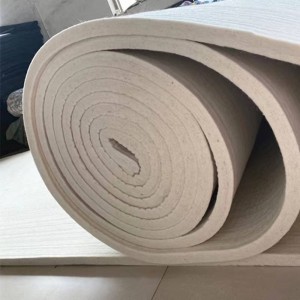Wool felt, with its long – standing cultural significance in many regions, is playing a pivotal role in the revival and preservation of intangible cultural heritage. As the world becomes more globalized and modernized, traditional crafts and cultural practices are at risk of being lost. However, through the efforts of artisans, cultural organizations, and enthusiasts, wool felt is being brought back into the spotlight, helping to safeguard the rich cultural heritage associated with it.
In regions such as Central Asia, the Caucasus, and parts of Europe, wool felt making has been a traditional craft passed down through generations. Each region has its unique techniques, patterns, and cultural stories embedded within the felt – making process. For instance, in Kyrgyzstan, the art of making shyrdak, a type of wool felt carpet with intricate geometric patterns, is an important part of the local cultural identity. These carpets are not only decorative items but also hold symbolic meanings, often representing family values, historical events, or natural elements. By reviving the production and promotion of shyrdak, Kyrgyz artisans are ensuring that this traditional craft and its associated cultural heritage are preserved for future generations.
Similarly, in Turkey, the art of wet felting, known as “kelle,” has a long history. Turkish kelle products, including hats, bags, and clothing, are characterized by their vibrant colors and unique designs. Through cultural exchange programs, workshops, and exhibitions, Turkish artisans are sharing their kelle – making techniques with the world, raising awareness about this traditional craft and its cultural significance. This not only helps to preserve the craft but also promotes cross – cultural understanding and appreciation.
In addition to regional traditional techniques, wool felt is also being used as a medium to tell cultural stories and preserve oral traditions. Artisans are creating felted sculptures, wall hangings, and other artworks that depict local folklore, myths, and historical events. These visual representations serve as a way to pass down cultural knowledge and stories from one generation to another, especially in communities where written records are scarce.
The revival of wool felt as a cultural heritage craft is also having an economic impact. In many rural and indigenous communities, traditional wool felt making provides a source of income for local artisans. By promoting and selling their felt products both locally and internationally, these artisans can support themselves and their families while also keeping their cultural traditions alive. Cultural tourism initiatives are also being developed around wool felt making, attracting visitors who are interested in learning about the craft and experiencing the local culture firsthand.
However, the preservation of wool felt as intangible cultural heritage is not without its challenges. The younger generation in many communities may be more attracted to modern, urban lifestyles and careers, leading to a potential loss of traditional skills. Additionally, the competition from mass – produced, low – cost felt products can make it difficult for traditional artisans to sustain their businesses. To overcome these challenges, it is essential to invest in education and training programs to pass on the craft skills, as well as to promote the unique cultural value and quality of traditional wool felt products.
As the world continues to recognize the importance of preserving intangible cultural heritage, wool felt will undoubtedly remain a key element in the efforts to safeguard the diverse cultural traditions and stories associated with it. Through the combined efforts of various stakeholders, wool felt can continue to thrive as a living cultural heritage for years to come.

Post time: May-30-2025
